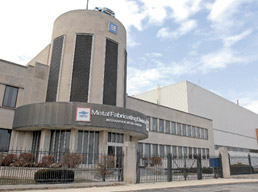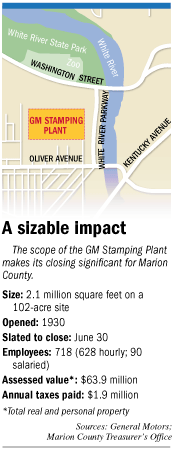Subscriber Benefit
As a subscriber you can listen to articles at work, in the car, or while you work out. Subscribe NowWhen the General Motors metal-stamping plant just west of downtown closes this summer, it could add to the blight in an already rundown neighborhood.
But city leaders are hoping to turn it into a prime opportunity.
During his State of the City speech Feb. 24, Mayor Greg Ballard announced the city is commissioning a task force of national experts to come up with a plan to redevelop it.
 The city is looking for ways to keep the GM Stamping Plant, slated for a June closing, from becoming an urban blight. (IBJ Photo/ Perry Reichanadter)
The city is looking for ways to keep the GM Stamping Plant, slated for a June closing, from becoming an urban blight. (IBJ Photo/ Perry Reichanadter)Develop Indy, the city’s economic development organization, will pay $115,000 for the study.
The 102-acre site lies near Lucas Oil Stadium and White River, potentially making it attractive for residential, retail entertainment or other non-industrial uses.
But Ballard and others at the city are still hoping that will be Plan B. Their first priority is finding a business for the site—another manufacturer, perhaps.
“The mayor would be happy if a new buyer could provide hundreds of jobs at the site, but if that’s not possible, we as a community need to be ready with a vision for a redevelopment of the site,” said Michael Huber, the city’s deputy mayor for economic development. “It could be the redevelopment opportunity of a generation in Indianapolis.”
It also could present a huge challenge.
Luring a new business or a developer to the site would be difficult, experts say. The supply of old industrial buildings exceeds the demand from the kinds of companies that might use them.
And while the location is appealing, there could be serious obstacles to redevelopment, including inspecting the site for potential environmental contaminants and footing the cost for demolition and possibly cleanup.
“The threshold issue is going to be what the environmental situation is,” said Dennis Dye, executive vice president of Browning Investments, a commercial development firm. “If you start over and want to redevelop it into a completely different use, it could have a negative value between cleanup and demolition and [underground work].”
A tough sell
Across the country, hundreds of sites have been shuttered by automakers over the last few decades as the country’s manufacturing base has eroded.
GM confirmed its plan to close its White River stamping plant, which opened in 1930, in its 2009 bankruptcy filing. At its peak, the plant employed about 5,000, but the work force has shrunk to about 700.
Today, the plant pays close to $2 million per year in real and personal property taxes.
Last year, there was hope of reviving the plant when Addison, Ill.-based JD Norman Industries made a bid to continue the stamping operation there.
The deal died after the local United Auto Workers union, whose members would have been retained but would have taken a pay cut, rejected it.
Since then, GM has said in documents filed with the Department of Workforce Development that the company intends to close the plant by June 30.
The site is in the hands of Motors Liquidation Co., the name the former GM adopted after filing for bankruptcy and selling its desired assets to a new company.
Motors Liquidation run by a group from Detroit-based consultancy Alix Partners, is charged with marketing the site. The city refers its sales inquiries about the plant to the company.
Huber said the city “has heard from many interested potential buyers,” but would not detail specifics.
 Tim Yost, a Motors Liquidation spokesman, also would not comment on what kinds of buyers are interested.
Tim Yost, a Motors Liquidation spokesman, also would not comment on what kinds of buyers are interested.
Some experts say attracting another industrial user would be tough.
“The one thing that would be a mistake would be to think the manufacturing would come back to that site,” said Ed McMahon, a senior resident fellow at the think tank Urban Land Institute who is not involved with the Indianapolis project. “In most cases, manufacturing is not coming back.”
That could be particularly true for auto manufacturing. Bernard Swiecki, a senior project manager with the Detroit-based Center for Automotive Research, said the “odds are very low” of another bidder such as JD Norman stepping in.
There are only a small number of stamping manufacturers in expansion mode, and the implosion of the discussions with Norman makes the site less appealing.
Other cities have successfully lured companies to their vacant plants.
Anderson, which has lost about 25,000 GM jobs since 1987, has sold many of its old buildings to such buyers as research-and-development firms, electronics makers and steel-splitting operations.
But older sites proved challenging in Anderson, said Linda Dawson, the city’s director of economic development.
Anderson asked GM to demolish a 2.5-million-square-foot facility built in the early 1900s because the city thought it would be too difficult to sell.
“We felt it was not conducive to what current companies are wanting,” Dawson said, “especially when you consider there’s a glut in the market right now of larger buildings that are newer.”
Even if the city lured a company there, McMahon said, the boon to taxpayers would be mitigated by the incentives that likely would have to be offered.
“Because there are so many communities competing for so few manufacturing facilities,” he said, “what they tend to do is give away the store on taxes.”
New uses
All those factors could make redevelopment a more likely option.
The city’s new task force will be led by former Indianapolis Mayor Bill Hudnut, a former Urban Land Institute fellow and consultant near Washington, D.C.
It also will include about 10 architects, developers, marketers and other land institute members. They’ll spend a week in Indianapolis this summer meeting with stakeholders and draft a plan based on their knowledge and feedback.
Hudnut said one of the options that could be explored is the concept of an urban neighborhood, similar to Fall Creek Place but with more retail in walking distances from the residences.
“What you want to do is try to stabilize the more central part of the city—hopefully with homeowners, not renters,” Hudnut said. “In this day and age, when a lot of people are struggling, housing in the city makes some sense” to lower transportation costs to work.
Other cities have done similar redevelopments, including Atlantic Station, a former steel plant in Atlanta that now houses residences, office space and entertainment. But the projects also bring challenges.
Testing for contaminants and cleanup is costly. Motors Liquidation has set aside $3.7 million for remediation at the site, but readying the site could require public investment.
City officials would not yet discuss the amount of contamination on the site.
Some who live in the area see other obstacles. Phyllis Usher is interim director of the Westside Community Development Corp. and lives on West Washington Street about a mile from the plant.
She questions whether there’s demand for additional downtown housing, particularly with competition from other projects in the area.
Still, Usher is hopeful for housing or retail, which she said could be a boon to the neighborhood surrounding the site. Several storefronts are boarded up, and some houses west of the site are abandoned.
“We’re just not empowered here in any way,” Usher said. “We have people who are just struggling to make a living.”•
Please enable JavaScript to view this content.
